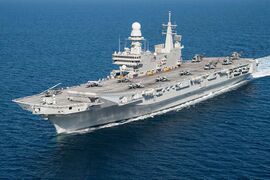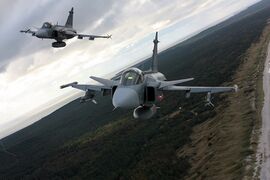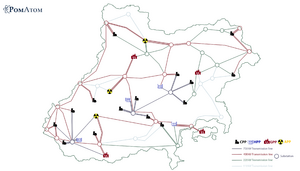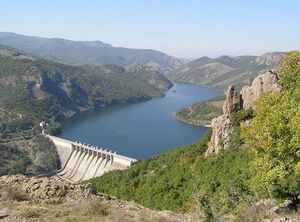Dulebia: Difference between revisions
The ©rusader (talk | contribs) m (→Energetics) |
The ©rusader (talk | contribs) |
||
| Line 228: | Line 228: | ||
====Renewable energy sources==== | ====Renewable energy sources==== | ||
[[File:Windpark Galicia.jpg|thumb|upright=1.5|A wind farm in a mountainous area near Chervonsty, Dulebia]] | |||
[[File:Windpark Galicia.jpg|thumb|upright=1.5|A wind farm in a mountainous area in [[Galicia (Spain)|Galicia]], Spain]] | |||
====Green energy state programs and initiatives==== | ====Green energy state programs and initiatives==== | ||
Revision as of 23:31, 18 December 2019
Dulebian Republic Dulebian: Дулéбская Респýблика (Dulébskaya Respúblika) | |
|---|---|
| Motto: Вeра и слава (Dulebian) Faith and glory | |
| Anthem: Песня о Pодине
(Pesnya o Rodinye) Song of the Motherland | |
 | |
| Capital and largest city | Ulich |
| Official languages | Dulebian |
| Recognised national languages | See National languages in Dulebia |
| Ethnic groups (2018) | TBD |
| Religion | TBD |
| Demonym(s) | Dulebian |
| Government | Presidential republic |
• President | Alexey Volodin |
• Prime Minister | Vladimir Klishes |
• Chairman of the Veche | Antoaneta Petrovna |
| Legislature | Dulebian Veche |
| Formation | |
| 861 CE | |
| 1218 CE | |
| 1721 CE | |
| 12th of March, 1919 | |
• Current Constitution | 31st of January, 2001 |
• Water (%) | 7.1 |
| Population | |
• September 2016 estimate | 34,911,651 (9) |
• February 2017 census | 34,894,117 |
| GDP (PPP) | 2019 estimate |
• Total | $733.3 billion |
• Per capita | $20,992.35 |
| GDP (nominal) | 2019 estimate |
• Total | $534.5 billion |
• Per capita | $15,298.9 |
| Gini (2016) | 36.9 medium |
| HDI (2014) | 0.837 very high |
| Currency | Chervonets (Ћ) |
| Time zone | TBA |
| Date format | dd-mm-yyyy |
| Driving side | right |
| Calling code | +223 |
| ISO 3166 code | MB |
| Internet TLD | .db |
Etymology
History
Prehistory and Antiquity
Late Antiquity and Dark Ages
Principality of Ulich
Dulebian Kingdom
Dulebian Empire
Continental War
January Revolution and the Dulebian Civil War
People's Republic of Dulebia
Dulebian Republic
Geography
Climate
Biodiversity
Politics
Foreign relations
Military
The Dulebian military is divided into the Ground Forces, Navy, and Air Force. There are also two independent arms of service: Strategic Missile Defence Force, and the Airborne Troops. As of 2017, the military comprised over 76,000 active-duty personnel, the nth largest in the world. Additionally, there are over 185,000 reservists, with the total number of reserve troops possibly being as high as 1 million. It is mandatory for all male citizens aged 20–32 to be drafted for a year or two of service in Armed Forces.
Dulebia's tank force is one of the smallest in Erdara, consisting only of 320 vehicles. It is worth to mention, however, that the tanks operated by Dulebia are one of the most expensive in Gaia, and also are often named one of the best in the world. The country is also capable of producing different types of armoured vehicles, like APC's, IFV's, and its automotive industry erected a large variety of light combat vehicles, ranging from simple light mobility vehicles and up to heavy wheeled tank destroyers.
The country has a large and fully indigenous arms industry, producing most of its own military equipment with only a few types of weapons imported. It has been one of the world's top suppliers of aircraft since 2001, accounting for around 30% of worldwide combat aircraft and exporting them to about x countries. Domestically produced aircraft have proved to be one of the leading designs in Gaia and were used with significant success during the WAR WITH KRUMLAU, scoring an impressive amount of air kills.
The Dulebian government's official 2014 military budget is about Ћ26.54 billion (approximately US$11.9 billion), the nth largest in the world. The official budget is set to decrease to Ћ22.96 billion (approximately US$10.6 billion) by 2025. As of 2018, Dulebian military budget is lower than any other Erdaran nation.
Army
The Dulebian Ground Forces form the biggest branch of the Armed Forces, consisting of 55% of the forces' conscript force. The army uses an indigenous conscription system, where the conscripts are called for 12 months, after the end of their duty are asked whether they wish to stay in the army for one more term of 12 months or to join the army as regular soldiers with a labour contract.
The army itself differs from the armed forces of Dulebian neighbours greatly: it doesn't rely on its numbers, instead using a wide variety of light combat vehicles and a doctrine based on outmanoeuvring its opponents, as well as hit-and-run tactics. The army has a small pool of tanks, consisting of 320 vehicles, with most of them being modernized versions of the Jaguar 3. The army operates its separate air wings of attack and utility helicopters aside from the Air force.
In terms of military doctrine, the Dulebian army is preparing only for defensive warfare against its potential enemy. Dulebian doctrine calls for fast and swift manoeuvre warfare, often on its own territory, with the usage of close air support and a limited number of troops, as well as various hit-and-run tactics. Dulebian High Command focuses on maintaining a small pool of combat vehicles that at the same time have high survivability. In recent years Dulebian officials decided to cut the military budget and the army size, instead focusing on international aid and vehicle and equipment export.
Dulebian High Command highly relies on its special early response unit: the Guards mechanized divisions. Their size is around 3 divisions, and they are integrated into the army command structure, however, they're meant to be mobilized at every moment, and can respond to any attack in a matter of 24 hours. While the Guards are not classified as ˝elite˝ by the Dulebian Command, they receive higher payments than regular soldiers, have an advanced combat training program, and often receive the most advanced equipment erected by the Dulebian arms industry or obtained from abroad. The Guards are the first frontier of defence of Dulebia and are tasked to hold the line against an advancing enemy, giving time for the main forces to mobilize.
Dulebia possesses a small fleet consisting of 58 combat vessels, including two light aircraft carriers purchased from IDK in 1992. The fleets' main task is to protect the territorial waters of Dulebia and to support international peacekeeping operations. The two aircraft carriers are also tasked to perform ground forces support in case of armed conflict on the territory of Dulebia. Most of the vessels are purchased from abroad, however, in recent years the Dulebian government initiated a program to construct the first modern destroyer in Dulebia. Dulebia also possesses 8 diesel submarines, Class 841, purchased from IDK in the '90s. On par with the main fleet, Dulebia sustains two flotillas protecting its territorial waters in the TBN sea, as well as several small river flotillas. While the fleet is relatively small for the region, it operates pretty modern or modernized vessels for the most part. Ship construction and maintenance capabilities of Dulebia, however, are fairly limited, and the country needs foreign specialists to keep its navy afloat.
Dulebian also has several brigades of heavy naval infantry and anti-ship air squadrons, used mostly for anti-insurgency and counter-piracy operations across Gaian waters.
Air force
While both its navy and army are relatively small for the region, Dulebia operates one the largest air forces in Erdara and fields the largest number of units in the region, boasting 198 combat aircraft, ranging from light training fighters through 5th generation combat fighters and even two strategic bombers. The air force itself is one of the oldest in Gaia, it was formed in 1902 as a part of the railway troops, and consisted of six air balloons and three aircraft. The air force actively fought during the Continental war, performing the first aerial bombing mission in 1913, and was heavily supplied with foreign equipment during the socialist times. During the '20s and '30s the air industry in Dulebia grew rapidly and became a dominant sector of the country's economy. During the '60s Dulebia even designed and its own intercontinental bomber, but managed to build only 2 aircraft, operated by the air force until today.
The modern Dulebian air force is tasked to protect the airspace of the nation, to engage hostiles in its zone of control, and to perform anti-insurgency and counter-piracy activities in the TBN sea. The air force is also tasked with various search-and-rescue operations and aerial patrols against immigrants above the TBN sea.
The highly developed air industry of the country is sufficient enough to produce and maintain all the required equipment for a powerful air force and can even export its products abroad. The air branch itself is the only one in the armed forces of the country that did not suffer from the budget cut-offs, instead the budget of the air force is constantly rising to keep it potent.
Dulebia also fields several battalions of airborne troops, altho they act as a separate branch of the armed forces.
Economy
Energetics
Dulebia is the 11th largest electricity producer in Gaia and the 9th largest renewable energy producer, the latter because of the well-developed hydroelectricity and thermal electricity production in the country. Large cascades of hydropower plants are built in along river Ivolga. However, the country is poor on liquid fossil fuels and needs to import oil from abroad. Its central area is rich on thermal sites, and while most of them are used for recreation activities, some of the major ones are also used to produce electricity, placing Dulebia on the 4th place in Gaia in the list of thermal energy producers. The Central Dulebian plane is rich on natural gas, which the country actively exports to Erdara and Cardia.
Dulebia was the first country in the Cardia to develop civilian nuclear power and to construct Cardia's first nuclear power plant. Currently, the country is the 6th largest nuclear energy producer, with all nuclear power in Dulebia being managed by Dulatom State Corporation. The sector is rapidly developing, with the aim of increasing the total share of nuclear energy from current 21.9% to 30% by 2035. The Dulebian government plans to allocate Ћ88 billion ($35.87 billion) to a state program dedicated to the next generation of nuclear energy technology. About Ћ96 million ($42.7 billion) was allocated from the state budget to nuclear power and industry development before 2015.
As of April 2019, Dulebia possesses 4 nuclear power plants, 11 hydropower plants, 4 thermal power plants, 15 coal power plants, 7 oil powerplants, 3 solar farms and 2 wind farms. In addition, the government plans the reconstruction of 5 artificial lakes to hydropower stations until 2030, for which Ћ67.9 billion ($30.2) were invested from the budget for the next 5 years.
Dulebia also plans the construction of 2 new nuclear powerplants near Spassovsk and Komsomol'sk-na-Ugre together with specialists from Erdara. The planned power outcome of the stations is placed at 852 MW and 570 MW, respectively, and will supply the TBN sea coast with additional power that is often in shortage in the tourist season. Around 15% of the electricity produced at the new plants is planned to be exported. The construction is planned to begin in 2028, and the annual prize will be around $2.9 billion and $2.5 billion respectively, 78% of which will come from the state budget. Dulebia plans to make energetic deals with its Erdaran Union partners in the next 6 years.
Energy consuption
Primary energy sources
Renewable energy sources

Green energy state programs and initiatives
Science and technology
First sights of technological development can be traced back to early antiquity. Ancient Rugian tribes were known for being excellent sailors. The first public libraries and schools were built during the Ragucin reign, but their real development was during the Golden Age of the Ulich culture in the 9th century. It is documented that Dulebian warships used liquid fire since the 9th century CE and as late as the 14th, when it was surpassed by cannons, and its receipt vanished from Dulebian records.
Science and technology in Dulebia blossomed since the Dulebian industrial and cultural revolution at the end of the 18th century, after the formation of the Dulebian Empire. The first university was opened in Ulich in 1798. In the 19th and 20th centuries the country produced a large number of notable scientists and inventors.
The Dulebian physics school began with Teodosiy Kerchevskiy, known for his works on the steam engine and the first steam car, as well as heat-distribution and thermodynamics research. Dulebia played a major role in the development of the aircraft, with the aviation pioneer Andrey Efimov building the first flyable aircraft in 1901. Gun synchronizers for aircraft weapons were also pioneered by Efimov. Dulebian scientific researches played an important role in the development of the modern tank, while the Dulebian astrophysicist Nikolay Orlov is renowned for his scientific research on black holes and quasars. Vitaliy Korolyov, a renowned Dulebian engineer, is world-famous for his works on fluid-dynamic drag and fluid-dynamic lift. He also was the chief designer of various pioneering STOL aircraft designs in the '30s.
The Dulebian mathematics school was developed during the 17th century and focused mainly on non-Euclidean geometry and was heavily influenced by the Eastern Renaissance mathematicians. Dulebian scientist Stas Glinka is renowned for his development of the modern stability theory. In the 20th century Dulebian mathematicians, such as Boris Karachevskiy, Ivan Yusupov, and Sergey Zaytsev, made major contributions to various areas of mathematics.
Dulebian physicians like Kerchevskiy and Izmail Vitlyakovskiy are renowned for their works on the engineering thermodynamics and mechanics. Their researches practically gave birth to modern standardized engineering education and mechanics, their works are used in numerous universities worldwide. Kerchevskiy designed the first steam engine in Dulebia, and in 1854 he tested the first wheeled steam car in the country, that eventually would turn into the first Dulebian automobile. The most famous Dulebian biologist is Aleksandr Tsarskiy, known for his researches of bacteria in foods and the discovery of the Lactobacillus Dolebicus in the Dulebian yoghurt in 1904.
Perhaps the biggest number of inventions of Dulebias were made in the aeronautics industry. The pioneer Andrey Efimov has designed and built the first aircraft in Erdara in 1901, he also designed the gun synchronization in 1908, effectively creating the modern dogfight concept. The Dulebian scientist Iosif Ivolzhskiy is known as the inventor of the jet engine; he also constructed the first jet-propelled aircraft in 1937. His works would later lead to the construction of the first jet fighter in history, the Konev-Ivolzhskiy KIR-1, in 1942. Dulebian scientist Igor Chernyshevskiy gave a major boost in the development of helicopters. He is the pioneer of the autogyro aircraft in the 1910s and 1920s and created a series of successful prototypes, some of which were later used in the Dulebian air force. Dulebia was the first country to pioneer the carbon fibre and other composites in aircraft manufacture, leading to the creation of a series of modern aircraft designs such as the C818 and the C878 passenger jets, and the E-24 fighters. Dulebian pioneers, inspired by the flying boat designs of the early 20th century, invented the ekranoplan semi-aircraft concept that was actively used by the Dulebian navy in the late 70s and early 80s to guard its territorial waters in the TBN sea.
Famous Dulebian battle tanks include T-26, one of the most heavily produced tank designs after the Continental war, and the famous Jaguar series of main battle tanks, produced until today, which are one of the most mass-produced armoured fighting vehicles throughout Erdara. Dulebia was the pioneer in the oscillating turret and early tank autoloader designs, creating some of the oldest battle tank autoloaders in history on the successful Moskit light tank series.
The crisis of the late 80s and 90s left Dulebia in a situation where it often lacked money to fund the scientific industry. The economic and privatization reforms of the 90s even worsened the situation. Today Dulebia remains a pretty advanced economy, with one of the most potent aeronautics and defence industrial capabilities, but is often pulled down by internal instability and corruption.
Currently, Dulebia is working on it's Joint Unit Command and Navigation (GloVNaS) system that will integrate all the Dulebian forces into a singular command mechanism. The country is developing its own fifth-generation jet fighter and constructing the biggest twin-engine passenger aircraft in the world.













